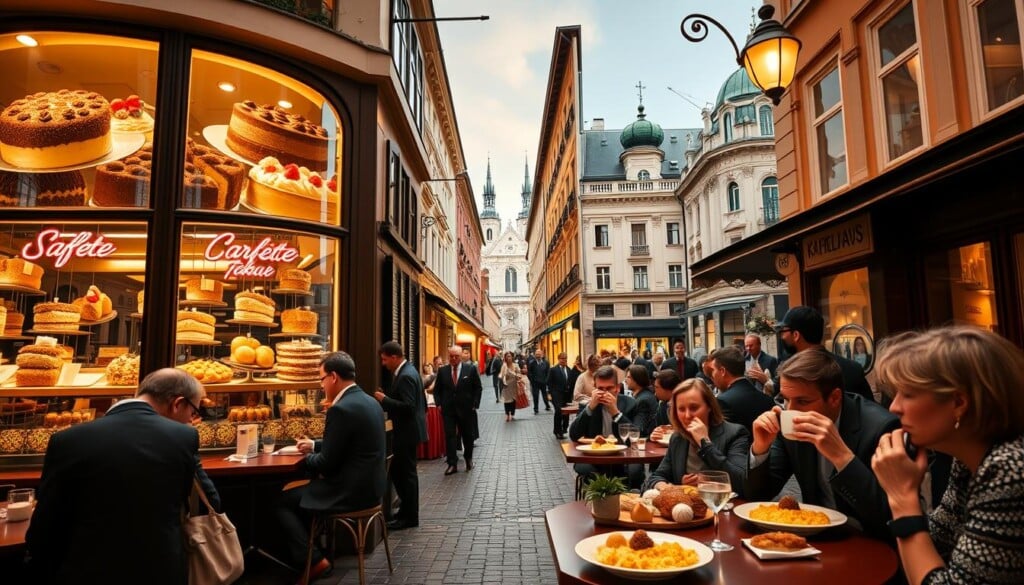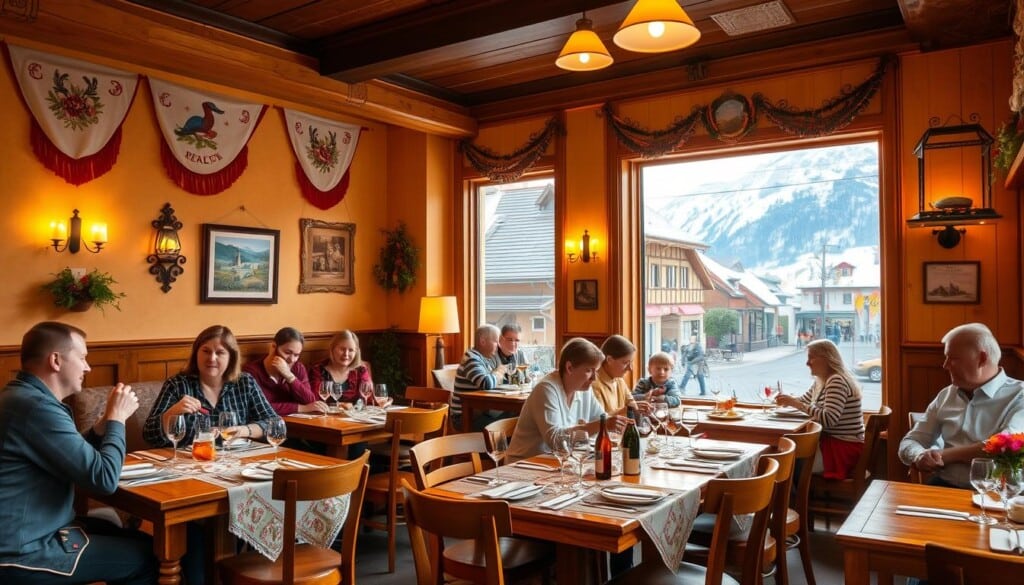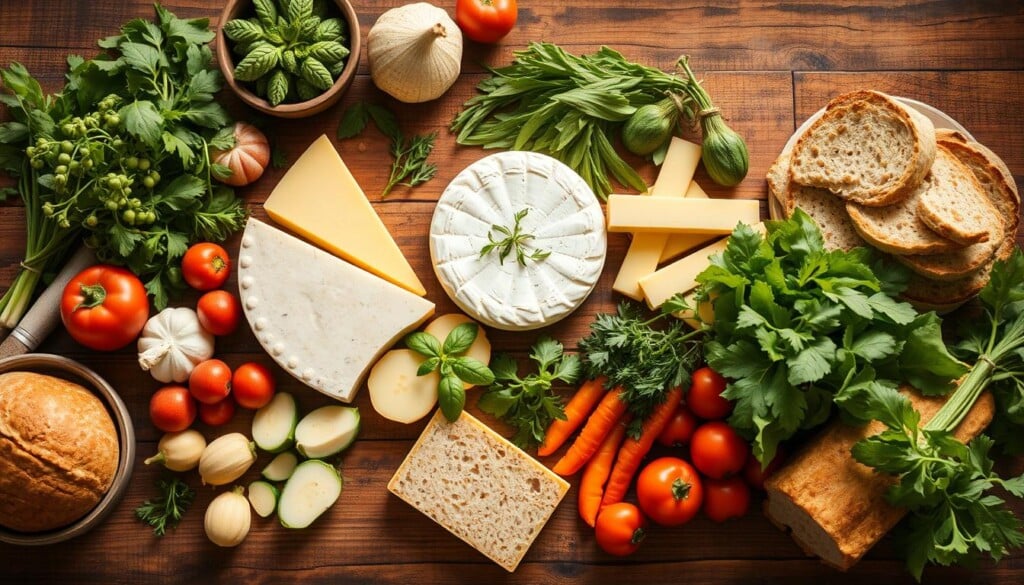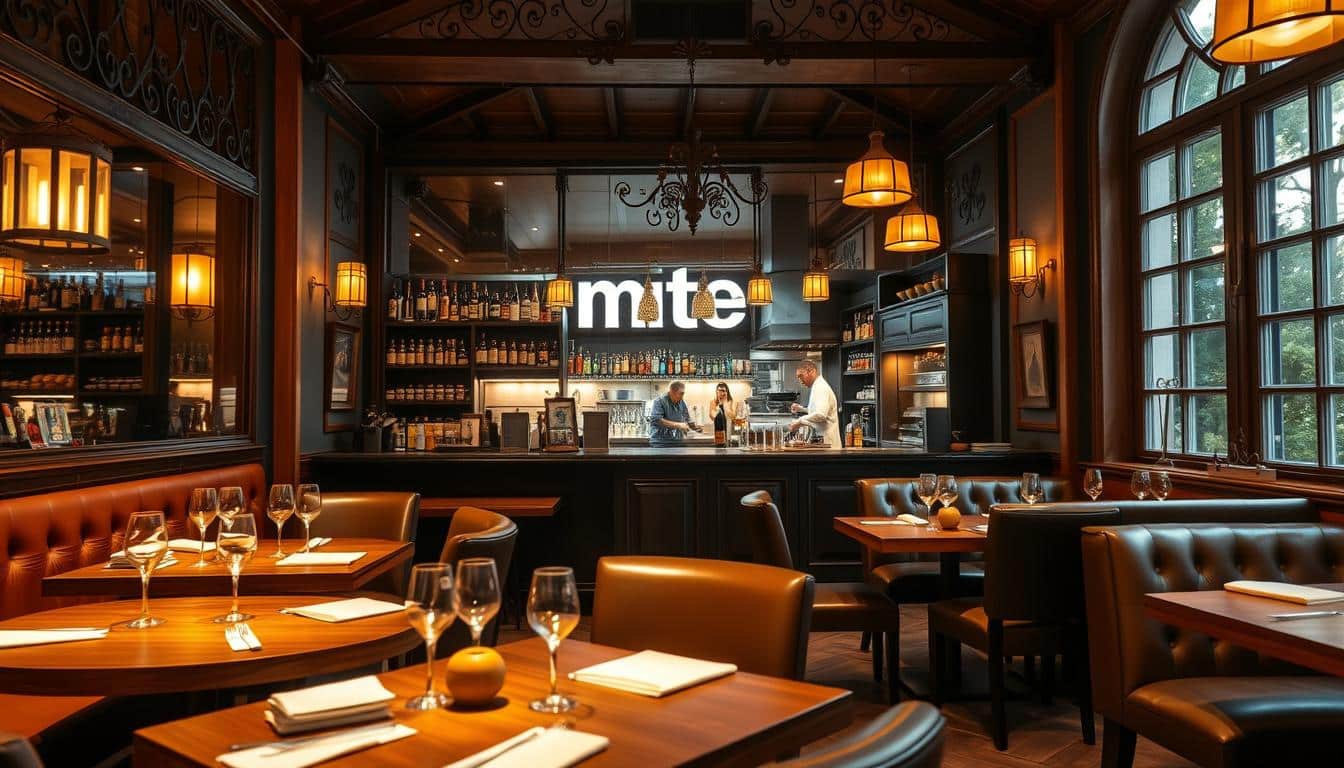Ever thought about how far you’d have to go for real Austrian food? The US has many top Austrian Food Restaurants. They offer a taste of Austria’s rich food culture. You can find these places in big cities and small towns.
These spots serve dishes like Wiener Schnitzel and Apfelstrudel. They bring Austria’s flavors to you. To find the best places, check out LocalZ. It helps you discover the unique tastes of Austria.
Key Takeaways
- The U.S. features a diverse range of top Austrian restaurants, each with authentic Austrian cuisine.
- Traditional dishes like Wiener Schnitzel and Tafelspitz are must-tries for any food enthusiast.
- Exploring local listings can enhance your dining experience and help you discover new flavors.
- Many Austrian restaurants focus on using local ingredients to create their menus.
- Dining atmospheres often reflect a blend of traditional and modern interpretations of Austrian culture.
Discover the Rich Flavors of Austrian Cuisine
Austrian cuisine is a feast for the senses, blending history and culture. It offers a wide range of traditional dishes that showcase Austria’s culinary heart. These dishes are beloved by both locals and tourists, highlighting the rich flavors and techniques that define Austrian food.
Traditional Dishes to Look For
Wiener Schnitzel is a must-try, with its crispy breaded veal cutlet. Tafelspitz, tender beef with root vegetables and broth, is another favorite. And no visit is complete without trying Apfelstrudel, a sweet apple-filled pastry.
These dishes are key to experiencing Austria’s vibrant food culture. They offer a taste of the country’s culinary heritage.
Unique Ingredients That Define Austrian Food
Smoked paprika gives many Austrian dishes a unique flavor. Dumplings add a delightful texture. High-quality meats and cheeses make each dish a masterpiece of culinary art.
The choice of ingredients is what sets Austrian food apart. It’s a key reason why Austrian cuisine is so special in Europe.
Popular Austrian Food Restaurants in Major Cities
Austrian cuisine has found a welcoming home in some of the most vibrant cities across the United States. The top Austrian restaurants in major metropolitan areas serve as cultural ambassadors. They bring the rich flavors of Austria to discerning diners. This section highlights some of the most popular Austrian food spots, showing a blend of tradition and contemporary culinary artistry.
Restaurants in New York City
New York City boasts a variety of fine dining Austrian restaurants. Notable establishments such as Wallsé and Schilling Restaurant & Bar are widely recognized. They are known for their authentic dishes and elegant atmospheres. Each restaurant offers a diverse menu that features traditional flavors alongside innovative interpretations.
This makes them must-visit spots for both locals and tourists.
Must-Visit Spots in Los Angeles
In Los Angeles, users can discover some of the freshest takes on Austrian classics. Places like The Little Door and Wurstküche introduce innovative spins on beloved dishes. They captivate food enthusiasts with their culinary diversity.
Each spot showcases the culinary diversity that Austrian restaurants can offer. They present a modern twist while honoring classic recipes.
Hidden Gems in Chicago
Chicago’s dining scene features a selection of hidden gems that exemplify the charm of popular Austrian food spots. Restaurants like Cafe Sabarsky and Austria serve mouthwatering dishes in cozy settings. These establishments may not have widespread acclaim but deliver memorable dining experiences.

How LocalZ Connects You to Austrian Food
Finding the perfect Austrian food restaurants is now easier than ever with LocalZ. This online directory makes it simple to find local services. It helps users discover a variety of dining options effortlessly. LocalZ is perfect for those who love authentic cuisine, providing a list of eateries specializing in Austrian dishes.
Search Listings Effortlessly
With LocalZ, finding Austrian food restaurants is easy. Users can use search filters to narrow down their options. They can filter by location, cuisine style, or specific dishes. This makes it easy to find the best spots near you.
Read Reviews and Ratings
Consumer feedback is key in the dining experience. LocalZ collects reviews and ratings for each restaurant. This helps users make informed choices. They can see the quality of service and food before booking a table.
Book a Table with Ease
Booking a table at your favorite restaurant is now simple. LocalZ lets users book tables directly through the platform. This feature makes dining out more accessible and convenient for everyone.
Signature Dishes You Need to Try
Exploring famous Austrian food specialties reveals a world of flavors. Each dish has its own story, blending traditional ingredients with old techniques. The best Austrian dishes are both simple and complex. Trying these delicious Austrian recipes is a must for anyone visiting Austrian restaurants.
Wiener Schnitzel: A Classic Favorite
The Wiener Schnitzel is perhaps the most famous Austrian dish. It’s a breaded veal cutlet, fried to golden. It’s served with a lemon wedge, showing Austrian cuisine’s perfect balance of taste and texture.
While pork or chicken versions exist, the veal remains the classic choice. For those looking for the best Austrian dishes, this is a must-try.
Tafelspitz: A Hearty Dish
Tafelspitz is a hearty meal loved by those who enjoy rich flavors. It’s slow-cooked beef in a rich broth, with root vegetables and horseradish sauce. This dish highlights the importance of local ingredients in Austrian cuisine.
Tafelspitz is a favorite among meat lovers, providing a satisfying experience.
Apfelstrudel: A Sweet Conclusion
Apfelstrudel is the perfect dessert to end your meal. It’s a pastry filled with spiced apples, raisins, and cinnamon. Served warm with vanilla ice cream or whipped cream, it’s a delightful treat.
As a standout among famous Austrian food specialties, Apfelstrudel leaves a lasting impression.
The Atmosphere of Austrian Dining
The atmosphere in Austrian dining places is key to a real Austrian dining experience. Each spot has its own special touches. These create a welcoming space, blending old traditions with new designs.
Cozy Ambiance that Reflects Tradition
Austrian restaurants are known for their warm lights, rustic wood, and traditional decor. This cozy feel makes diners feel like they’re part of a family. It brings back memories as they enjoy classic dishes and drinks.
Modern Interpretations of Classic Spaces
Some places mix old Austrian styles with modern touches. They use sleek lines and new decor. This attracts more people and keeps Austrian cuisine fresh in today’s world.
Best Austrian Restaurants for Families
Finding family-friendly Austrian restaurants makes dining out fun for everyone. Many places offer great options for kids. These spots are perfect for a memorable meal where everyone can enjoy Austrian food together.

Kid-Friendly Menus and Options
Many Austrian restaurants have menus just for kids. They offer smaller portions of classic dishes and creative vegetarian choices. Kids love the mild schnitzels, making them a hit with even the pickiest eaters.
Space for Large Gatherings
For big family events, finding a place with lots of room is key. Many Austrian restaurants have big areas for groups of all sizes. They’re great for birthdays or reunions, where you can enjoy Austrian food and celebrate together. Check out LocalZ for more dining ideas.
Vegetarian and Vegan Options in Austrian Cuisine
Austrian cuisine is now more inclusive, with a focus on vegetarian and vegan dishes. Old recipes are being updated to include plant-based meals. This way, everyone can enjoy the flavors of Austria without animal products.
Restaurants are leading this change. They show that classic dishes can be made vegan and stay true to their roots. This is a big win for those who follow a plant-based diet.
Traditional Dishes Made Plant-Based
Many Austrian favorites are now available as vegetarian or vegan options. For example, the Wiener Schnitzel has a plant-based version. Chefs use new ingredients to make these dishes taste just like the originals.
Even desserts like Apfelstrudel are made with vegan dough. This shows Austrian cuisine’s flexibility. It can meet different dietary needs while staying authentic.
Creative Culinary Innovations
Chefs are always coming up with new ideas in the kitchen. They mix local ingredients with global plant-based trends. This creates unique dishes that are both tasty and innovative.
For example, vegan Tafelspitz uses root veggies and grains for deep flavors. This trend offers more vegan options. It shows a dedication to quality and creativity in cooking.
The Importance of Local Ingredients
Using local ingredients is key to making Austrian food taste better. Restaurants get their ingredients from nearby farms. This way, they offer fresh and seasonal dishes.
This approach improves the quality of meals. It also keeps the unique flavors of Austria alive. These flavors are what make Austrian food special.
Sourcing Food from Local Farms
Restaurants that use local food connect with the community. This farm-to-table method means ingredients are always at their best. Diners get to enjoy the real taste of Austrian dishes.
By supporting local farms, chefs can create menus that show off their area’s food variety. This makes dining a unique experience.
Supporting Sustainable Practices
Choosing local ingredients helps the environment. It cuts down on emissions and energy needed for long-distance shipping. This is good for the planet.
It also helps the local economy grow. This way, food and sustainability go hand in hand. It’s a win-win for everyone.

Why Choose LocalZ for Your Dining Needs
LocalZ is a key tool for finding real dining experiences that highlight local tastes. It connects local businesses with people, helping them support amazing Austrian food spots. This way, it enriches the local food scene.
Connecting Businesses and Communities
LocalZ focuses on the bond between businesses and customers. It helps users find great places to eat and supports local restaurants. This helps both businesses and diners, making the community stronger.
Giving Back to Local Organizations
LocalZ also gives back by donating half of its fees to local groups. By using LocalZ, people enjoy great food and help their neighborhoods. It’s a way to make a difference while enjoying meals.
Customer Experiences in Austrian Restaurants
People who have eaten at Austrian restaurants share a lot about their experiences. They talk about the food, service, and atmosphere. Their stories help others know what to expect.
Reviews from diners show the happiness and satisfaction of eating well. They highlight the joy of a great meal.
Real Reviews from Local Diners
Local diners love the real tastes at Austrian places. They praise the fresh ingredients and how the food looks. They also mention the friendly staff who make the place welcoming.
These things together make dining memorable. They stand out among all the food choices.
Highlights from Guest Experiences
Guests often share stories of their favorite moments. They talk about dishes like Wiener Schnitzel or desserts like Apfelstrudel. These stories make each visit special.
The sense of community at these restaurants adds to the fun. It turns a meal into a cherished memory.
How to Find Your Perfect Austrian Restaurant Today
Finding the perfect Austrian restaurant is easier with the LocalZ directory. It’s a great tool for those looking for real Austrian food. You can use filters for location, cuisine, and special offers to find the right place.
Navigating the LocalZ Directory
The LocalZ directory makes finding restaurants easy. You can search by keyword or browse categories. Each restaurant’s profile includes details like menus and contact info, helping you choose wisely.
Special Offers and Promotions to Look For
Look for special deals in the LocalZ directory to make dining out better. Restaurants often have discounts or seasonal specials. These offers let you enjoy Austrian food without spending too much.

